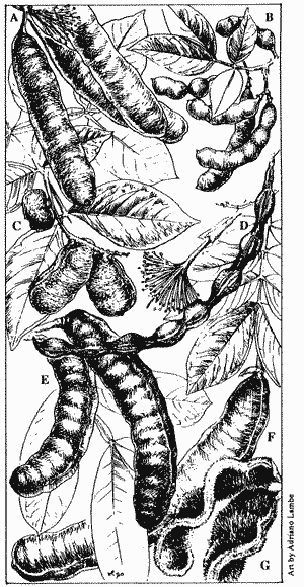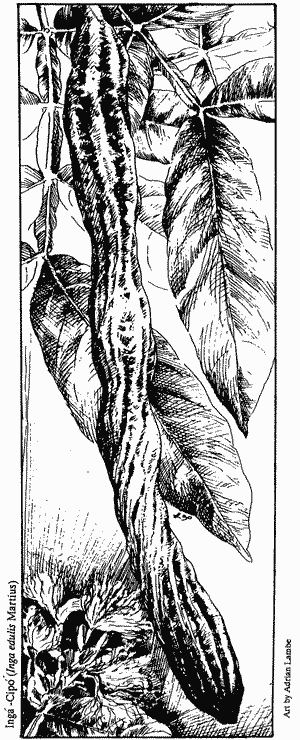
The Ingas of the Brazilian Amazon
Scientific Name: Inga species
Family: Leguminosae
Translated from the Portuguese and illustrated by Adriano
Lambe. It is from Paulo Cavalcante's Edible Fruits of the Amazon (in
Portuguese), Museu Paraenese Emilio Goeldi, Belém, Para 1988.

A: Inga cinnamomea; B: Inga heterophylla; C: Inga fagifolia; D: Inga alba; E: Inga capitata; F: Inga macrophylla; G: Inga velutina.
The genus Inga,
Leguminosae (Mimosoideae), is represented by approximately 180 species
in the Brazilian Amazon and, of this number, there are but a handful of
4 to 5 species having any appreciable quality as edible, fresh fruit.
Without question, first place goes to "inga cipo" (Inga edulis), significantly improved through cultivation; and, second place, just as surely, goes to "inga-acu" (Inga cinnamomea). The other species described here follow these two in importance, I. capitata, I. velutina, I. macrophylla, and I. alba.
There is another group of Ingas with less abundant and less appealing
portions, but which are appreciated by children in particular, and are
useful as a survival food: "xixica" (I. alba), "inga de macaco" (I. fagifolia), "ingai" (I. heterophyllus), etc.
INGA AÇU, Inga cinnamomea Beth. (Inga chinela, "thong inga"; Inga grossa, thick inga.)
This
is a medium-sized tree, 12 to 15 meters high when cultivated, but up to
30 meters in the wild, with quite a thick trunk. The forest trees have
hollow branches in which tachi ants live (Pseudomyrna, which also live in Tachia guianensis, whence their name 1).
The leaves are made up of three pairs of elliptical leaflets, glabrous
and papery, varying in size from 10 to 27 cm by 3.5 to 10 cm, the
largest always found at the end of the foliar rachis. The inflorescence
is composed of globose capituli 2 with pure white, heavily scented
flowers, the total length being about 17 mm. There are numerous
stamens, fused into tubes up to slightly above the corolla. The pod is
subcylindrical and a thick, cane-green when mature. It is up to 30 cm
long and weighs up to 400 grams, with abundant, sweet, white pulp,
strongly attached to the membranous testa. The seeds are oblong, about
3 cm long, arranged transversely in the pod, formed of two thick
cotyledons. The number of seeds varies with the size of the pod, 2
seeds in the smaller ones and up to 15 in the largest.
Inga-açu is a
native of the Brazilian Amazon, its geographical area extending as far
as the Guianas. It is common in its wild state, in the marginal meadows
along the Amazon River from its estuary as far as Peru, and along the
Madeira and Purus rivers as far as Acre. It is extensively cultivated
in the states of Pará and Amazonas, its fruits abounding in the markets
of Belém in the months from March to May, as well as occasionally in
November and December.
INGA-CIPO, Inga edulis Mart. Leguminosae (Mimosoideae)
Common Names
Inga,
Rabo de mica ("monkey tail"), Guamo (Colombia); Pois sucré ("sweet
pea") French Guiana; Guamo bejuco ("liana"), Venezuela; Shimbile, Guabo
(Peru); Guava machek (Panama); Ice Cream Bean (West Indies); Ingaguazu
("great") Argentina; Guamo (Costa Rica); Pois Doux ("tender/sweet pea")
Martinique.

A drawing of Inga edulis pod, leaves and flowers.
Medium-sized
tree, around 10-15 m high, occasionally to 25 m (Poncy 1985:64), low
trunk, branching at times near the base, with a sparse crown. The
leaves are compound, pinnate, the rachis winged with 4-6 pairs of
subsessile leaflets, elliptical or oval, the lower ones invariably
smaller, their base obtuse or rounded, the lateral veins are uniformly
parallel with glands between the petioles. The terminal, or subterminal
inflorescences are grouped in the leaf axils. The flowers are whitish,
scented, sessile, and bunched at the end of the rachis. The calyx and
corolla are tube-like, with about 80 stamens, the delicate filaments
joined in a tube along half their length.
The Fruit
The
fruit is a cylindrical pod, with many furrows along its length, olive
green, from 50-100 cm long, exceptionally to a meter and a half. The
exocarp is woody, and does not open spontaneously, with oblong seeds up
to 3.5 cm long, and made up of two thick, shiny black cotyledons, the
membranous testa dressed in white pulp (aril) which is soft, slightly
fibrous and sweet tasting. Germination is precocious, initiating in the
ripe fruit, at times while still on the tree.
Distribution
The
"ingazeiro" is widespread in South America, extending across all of
Brazil, except perhaps the extreme south, and is found in lands to the
north and east, Central America and West Indies.
According to Ducke (1949:33) there are two varieties of Inga edulis in existence, parvifolia and typica.
The second variety, which is the one described here is the real
"inga-cipo", with relatively large flowers and very long, thick fruits,
which apparently only occur near settlements where it is intensively
cultivated.
It is one of the most popular fruit trees in the
entire region, spreading spontaneously, and with great ease from
abandoned seeds, especially in humus-rich or semi-sandy soils. It grows
rapidly and may begin to bear fruit at 2 years of age, however it has a
life span of only 20 years, or considerably less.
Use and Marketing
The
pulp around the seeds is eaten fresh, indeed, there appears to be no
other way to eat it. Flowering and fruiting seasons vary with
individual specimens but 3 crops a year are possible. It is
particularly in August and September that the markets of Belém are
stocked high with the fruit.
The Ingas are still waiting for
their Boswell. As Mr. Lambe pointed out, there are over 180 species in
Brazil alone and, as you can imagine, the form and size of their fruit
varies tremendously, some of which he has illustrated above.
1 Translator's note.
2 A dense cluster of sessile or stalkless flowers.
Back to
Ice Cream Bean Page
|


